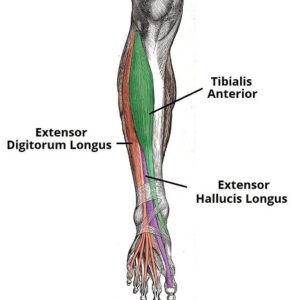Overview
The Ankle Dorsiflexion (Toes-Up) Drill is an activation and mobility exercise targeting the tibialis anterior and associated dorsiflexor muscles of the lower leg. Performed while standing upright, this drill involves lifting the forefoot and toes off the floor while keeping the heels grounded, activating the muscles responsible for ankle dorsiflexion.
It is commonly used in corrective exercise routines, shin splint prevention, ankle rehab, and posture restoration programs. This movement trains muscles often overlooked in typical lower-body workouts.
How to Perform the Ankle Dorsiflexion

Starting Position: Stand upright with feet hip-width apart, arms relaxed by your sides or placed on your hips.
Set the Feet: Keep your heels planted firmly on the ground, with your bodyweight evenly distributed.
Lift the Toes: Actively raise your forefoot and toes upward off the ground, pulling them toward your shins. Your heels must remain down.
Pause at the Top: Hold the top position for 1–2 seconds, feeling the contraction along the front of your shin.
Lower Slowly: Bring your toes and forefoot back to the ground with control.
Repeat: Perform 10–20 repetitions depending on your goal, focusing on activation and balance.
Tips for Proper Form
Keep your body upright—avoid leaning back to cheat the range.
Engage the shin muscles actively rather than relying on momentum.
Use a wall or surface for balance if needed, especially when starting.
Lift the toes as high as possible without straining or lifting your heels.
Control the descent—don’t let your toes flop down.
Common Mistakes
Leaning back to assist the lift with momentum.
Lifting the heels—this negates the dorsiflexion training effect.
Using only the big toe—engage the full forefoot for balanced activation.
Speeding through reps—this reduces control and muscle recruitment.
Performing barefoot on hard floors—can be uncomfortable; use a mat if needed.
Benefits of the Ankle Dorsiflexion
Strengthens tibialis anterior: Builds the key dorsiflexor muscle responsible for toe lift and ankle positioning.
Improves foot posture and control: Helps correct flat foot tendencies and enhance arch awareness.
Prevents shin splints: Strengthens the muscle often associated with anterior tibial stress syndrome.
Enhances gait and walking efficiency: Supports foot lift during stride, reducing tripping risk and improving step fluidity.
Increases ankle joint balance: Trains antagonistic control to balance out frequent plantar flexion movements (e.g., calf raises).
Low-impact and joint-friendly: Ideal for beginners, rehab clients, and older adults.
Can be done anywhere: No equipment needed; perfect for quick sets during daily routines.
How to Incorporate Into Your Routine
- For Activation Before Training: Perform 2–3 sets of 10–15 reps before lower-body workouts or running to engage dorsiflexors.
- For Shin Splint Prevention: Include 3–4 times per week as part of a rehab or prehab strategy.
- For Posture and Foot Health: Use in combination with arch-strengthening and balance drills.
- For Runners and Walkers: Perform during cooldowns to combat overuse of the calves and strengthen opposing muscles.
- For Standing Desk Users: Do a few reps every hour to activate feet and shins and improve lower limb circulation.
Muscles Worked

Frequently Asked Questions
Should I feel this in my shins?
Yes, a strong contraction should be felt along the front of your shin, especially near the ankle.
Can I do this exercise daily?
Yes. It’s low-impact and suitable for daily use, especially for improving foot control or rehabbing shin pain.
Do I need to wear shoes for this?
Shoes aren’t required, but you can perform it barefoot or in minimalist shoes for better muscle feedback.
What if I can’t lift my toes very high?
Start with what range you have. Over time, strength and control will improve with consistency.
Can this help with balance?
Absolutely. Strengthening the tibialis anterior improves ankle stability, which directly affects balance and foot coordination.
